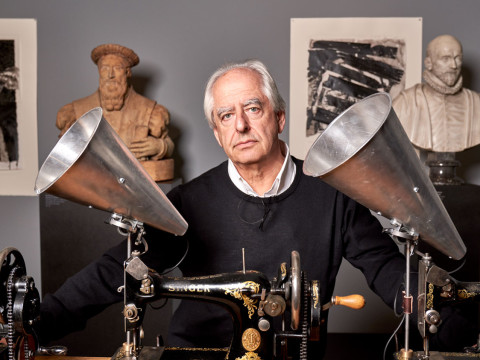
Six of the best: artist-gardeners
By Tom Jeffreys
Published on 28 September 2015
In 2016, the Royal Academy explores the influence that gardens exerted on the evolution of art from the 1860s to the 1920s. Here we pick out six of the greatest artist-gardeners from ‘Painting the Modern Garden: Monet to Matisse’.
1. Claude Monet
“Monet is the artist-gardener par excellence,” says the exhibition’s curator, Ann Dumas. “No other artist was as serious a gardener or as knowledgeable.” Perhaps more than any other painter, Monet is known for his paintings of gardens – in particular the one he created at Giverny, in Normandy (pictured above). From the mid-1890s, after he had purchased the house and surrounding land, Monet redesigned the garden in meticulous detail, showcasing exotic new arrivals to Europe such as irises and chrysanthemums.
Giverny came to dominate not only Monet’s life but his work too: the garden was his principle subject for the last 20 years of his life. From the early Spring Flowers (1864) to large, late depictions of light on water lilies: Monet’s work is at the heart of Painting the Modern Garden. As the artist himself famously put it: “I perhaps owe having become a painter to flowers.”
2. Gustave Caillebotte
Today’s enthusiasm for lawns and decking can perhaps be traced to the late 19th century. Greenhouses had become more affordable, which enabled not just botanical institutions such as Kew Gardens but also the emerging middle classes to cultivate their own exotic flowers. Gardening was no longer restricted either to aristocratic parkland or to utilitarian food production: it had started to become accessible to the new bourgeois society.
Gustave Caillebotte – best-known for his paintings of urban Paris – stopped exhibiting his work at the age of 34 and devoted his life to horticulture. At Petit-Gennevillers, not far from Monet’s garden at Giverny, Caillebotte cultivated his own impressive garden, visited regularly by both Monet and Renoir. His vivid painting Dahlias: The Garden at Petit-Gennevilliers provides a valuable insight into the history of horticulture at the time.

3. Pierre Bonnard
During this period, a new kind of garden aesthetic emerged. Monet, in particular, was influenced by the leading English garden designers of the period – the likes of William Robinson and Gertrude Jekyll. In The Wild Garden, Robinson argued for a break from the formal gardens of the past; instead advocating planting in loose drafts of colour. The garden of French artist Pierre Bonnard at Vernonnet, in northern France, adopted a similar approach, allowing the garden to run wild and free. He even called it his jardin sauvage (“wild garden”).
This kind of wild garden is captured in Bonnard’s Resting in the Garden (Sieste au jardin) (1914). In the foreground, a woman reclines on a chaise-longue. In the centre stands a large tree, picked out against the vivid fields beyond in Bonnard’s characteristically energetic brushstrokes, which echo the freedom of the garden itself. As Ann Dumas says, “the painting looks as much like a landscape as a garden”.

4. Emil Nolde
The era’s fascination with gardens was not confined to Impressionism. Matisse, Klimt and Kandinsky were all inspired by gardens to varying degrees. In fact, letters from Kandinsky to German artist Gabriele Münter suggest he thought of little else but the progress of his lettuces and strawberries. But none of these three displayed quite the sustained relationship between art and the practice of gardening as pioneering German Expressionist artist Emil Nolde. In 1927, Nolde designed Seebüll, a house in northern Germany near the border with Denmark, where he lived until his death in 1956. Long influenced by van Gogh, Nolde’s work was dominated by a heightened sense of colour, and the flowers he planted at Seebüll provided great opportunities for experimentation. He even planted two flowerbeds in the initials of himself and his wife Ada.

5. Joaquín Sorolla
One of the most charismatic works in Painting the Modern Garden is Joaquín Sorolla’s portrait of Louis Comfort Tiffany. Tiffany – the famous American stained-glass designer – is depicted at an easel in his garden in Long Island, elegantly clad in white linen, with his dog at his side, and surrounded by the great sea of yellow flowers.
What may be less well known to UK audiences is that Sorolla, one of Spain’s most important artists of the period, created his own beautiful garden at his house in Madrid. Sorolla was inspired by the tradition of Islamic gardens in Spain – such as The Alhambra in Granada – and the garden is characterised by formal areas that combine flowers with decorative tiles and paving. The house was converted into a museum in 1932 and the gardens have recently been restored.

6. Max Liebermann
German Impressionist Max Liebermann had a very different conception of gardening to Monet. Influenced by the German garden reform movement that emphasised rational, healthy design, Liebermann enlisted Alfred Brodersen to help divide the garden into a series of outdoor “green chambers”. Prominent features of the garden, which has recently been restored, include hedge gardens surrounded by boxwood, a vegetable garden (in the style of an English herbaceous border) and a long avenue of silver birches running down to Lake Wansee. In front of the house are a series of large formal flowerbeds which Liebermann planted in monochrome schemes.
Like Nolde and Monet, Libermann planted sections of the garden specifically to create motifs for his paintings. ‘Painting the Modern Garden’ includes some five paintings by Liebermann, showcasing different aspects of his approach to painting plants and gardens.
Painting the Modern Garden: Monet to Matisse is in the Main Galleries of Burlington House from 30 January — 20 April 2016.
Tom Jeffreys (@tomjeffreys) is a writer, editor and curator.
Related articles

A beginner's guide to William Kentridge
19 July 2022

13 things to know about Francis Bacon
14 February 2022

Light Lines Tour with Hélène Binet
23 November 2021